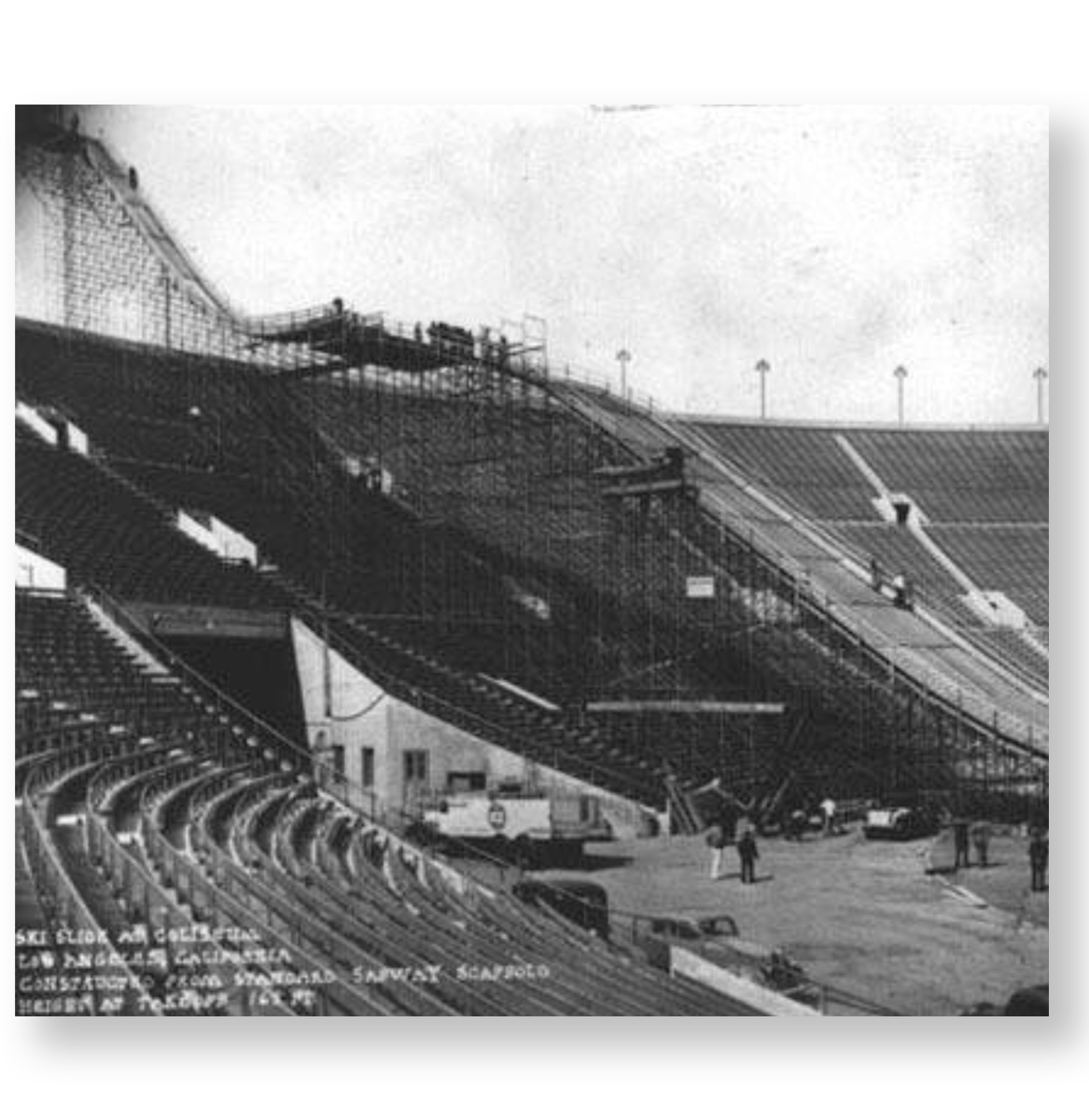January 1
1923
USC vs. Penn State in 9th Rose Bowl
Back on January 1, 1923, USC played Penn State in the 9th Rose Bowl, winning with a final score of 14-3.
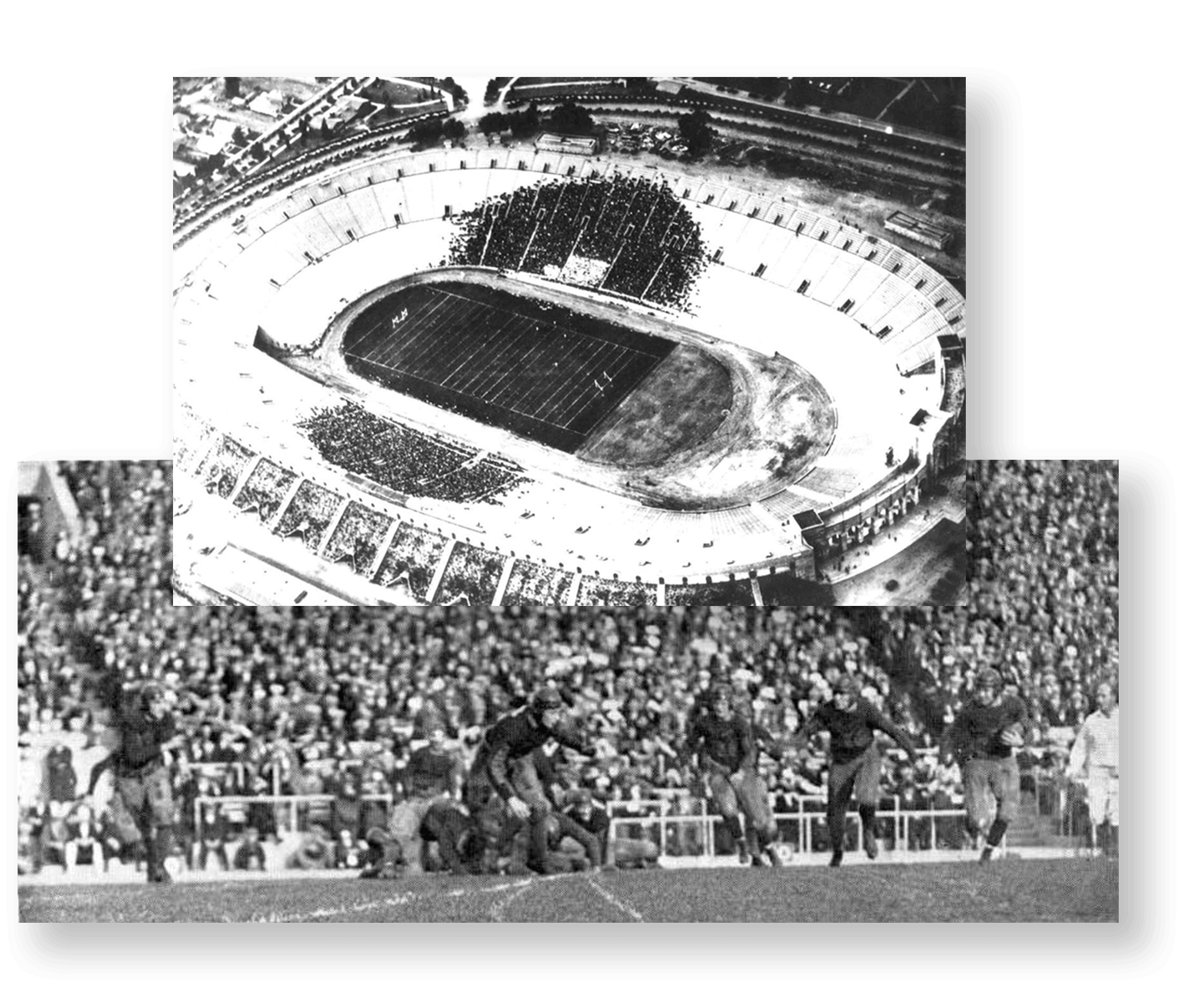
May 1
1923
Coliseum Construction Completed
After breaking ground on December 21, 1921, the Coliseum's construction was completed on May 1, 1923, with a capacity of 75,000.
The Coliseum was commissioned to be built in 1921 as a memorial to Los Angeles veterans of World War I. The stadium was designed by notable local architects John and Donald Parkinson, a father-and-son architectural team. The original bowl’s preliminary construction costs were $954,873.
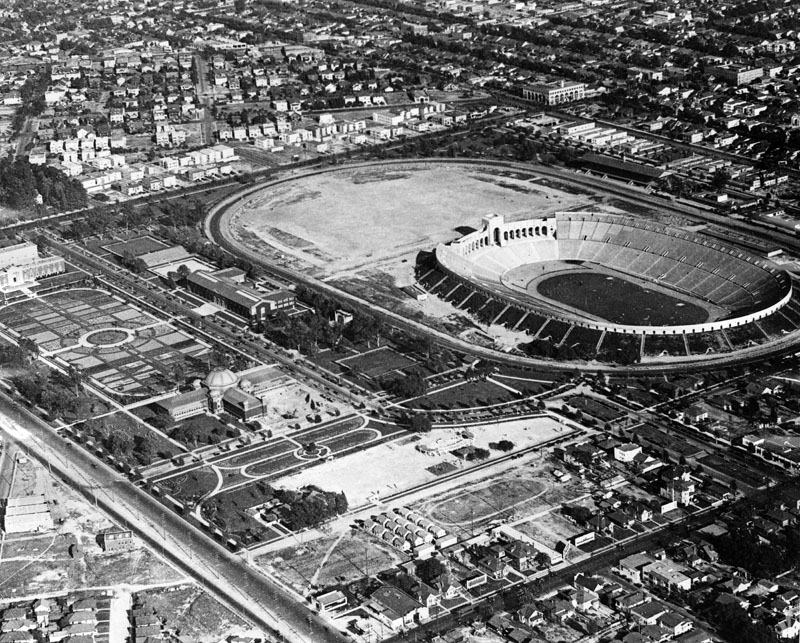
July 2
1923
The American Historical Review & Motion Picture Industrial Exposition
The American Historical Review and Motion Picture Industrial Exposition was the first event held at the Los Angeles Memorial Coliseum, less than two months after construction was completed. The event ran from July 2 to August 4, 1923 and attracted more than 300,000 spectators. Coined “The Greatest Attraction in the Southwest This Year," the expo promised to present both “the highlights of American history” as well as “every phase of the motion picture industry.”
The story of this historic event is unique and vast. Read more about it on the Homestead Museum's blog.
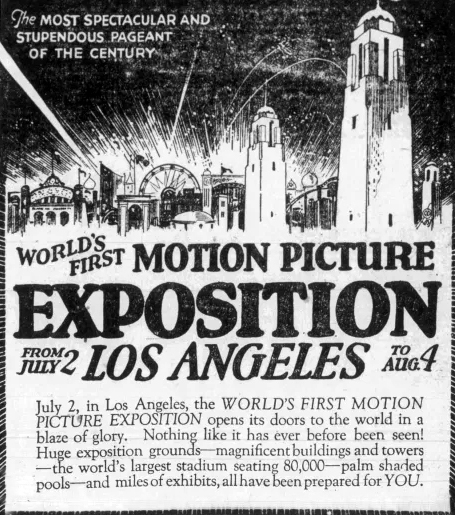
October 6
1923
USC vs. Pomona-Pitzer: The Coliseum’s First Game
Several months after the Los Angeles Memorial Coliseum opened its doors to the Los Angeles community, over 20,000 fans swarmed through the entrance to watch the Coliseum’s first ever football game: USC vs. Pomona-Pitzer. The game was a doubleheader, opened by USC’s Freshmen team, known as the “Peagreeners,” playing Santa Ana High School. Next up, the Trojans swept the field against Pomona in a 23-7 win, guided by Coach Henderson. USC showed the crowd they were perfectly at home in their shiny new bowl, equipped with all the comforts and amenities of what was coined the “Greatest Stadium in the World.”
The game was carried by USC’s Dolley and Campbell, who were running through Pomona’s defense until they were dizzy. By halftime, the score was USC 17; Pomona 0. In the second half, Pomona scored their sole touchdown. This was USC’s first of hundreds of wins in the Los Angeles Memorial Coliseum, and the first fans of millions to watch football in the stadium.
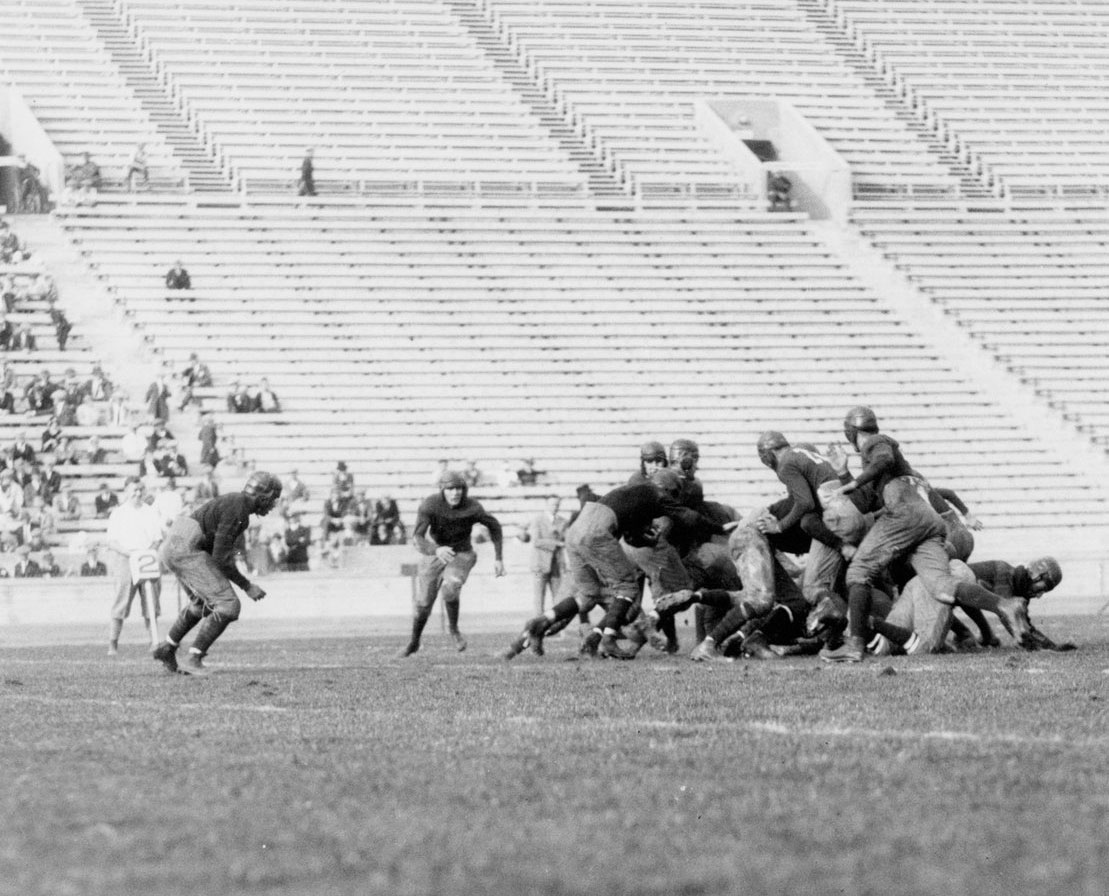
April 10
1925
“Bull” Montana vs. Jack Dempsey
In the early 1920s, Luigi Montagna, better known as "Bull" Montana, often wrestled with his friend Jack Dempsey, a world champion fighter, prior to some of Dempsey's larger fights to help entertain the press and spectators. The duo teamed for a 1925 special exhibition in connection with the U.S. battle fleet's athletic day at the Los Angeles Memorial Coliseum.
The exhibition featured men and women champions in various sports; the crowd was filled with officers and enlisted men within the armed forces who were being honored. According to wrestling historian, J. Michael Kenyon: "The two celluloid artists attacked each other with convincing fury, scorning custard pies and other studio weapons, and battling with their bare hands. Dempsey finally heaved the Bull through the ropes after ten minutes of what was called wrestling and was conceded the victory."
Dempsey continued to box in exhibition matches until 1940, but he was never a serious contender again. He became a successful restaurateur in New York City and remained a popular figure until his death in 1983. As for Montana, he continued playing movie bits into the 1940s. He died on January 24, 1950 in Los Angeles, California.
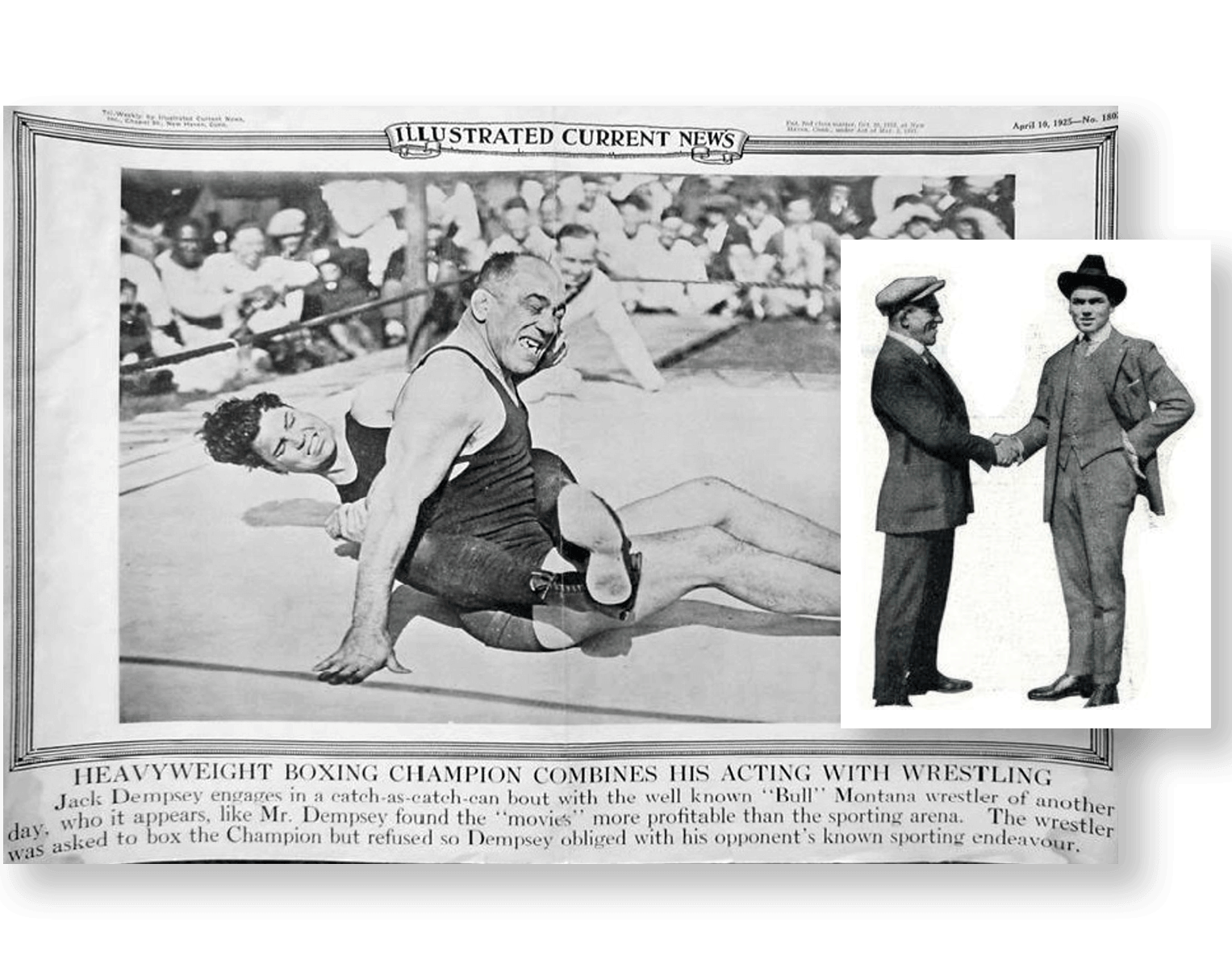
April 25
1925
Paavo Nurmi: World’s Greatest Distance Runner
Paavo Nurmi, arguably the world's greatest distance runner, held a track meet at the Coliseum. With over 500 athletes competing, many of them recent Olympians, Nurmi, of Finland, was the clear star attraction. Known as the "Flying Finn," Nurmi raced against American Lloyd Hahn to try and break the world record in the mile & a half race, as well as other exhibition events against local Native American tribes from California.
One of Nurmi's most impressive talents was not only his speed but his rare skill to adjust his pace in a variety of different races, from the 1500m to the 10,000m — even competing in the 3000m steeplechase!
Throughout the course of his career, Nurmi set 22 world records and won nine gold & three silver medals in his 12 track & field events at the Olympics (1920, 1924 and 1928). Nurmi, who rarely ran without a stopwatch in his hand, has been credited for introducing the "even pace" strategy and analytic approach to running, as well as for making running a major international sport.
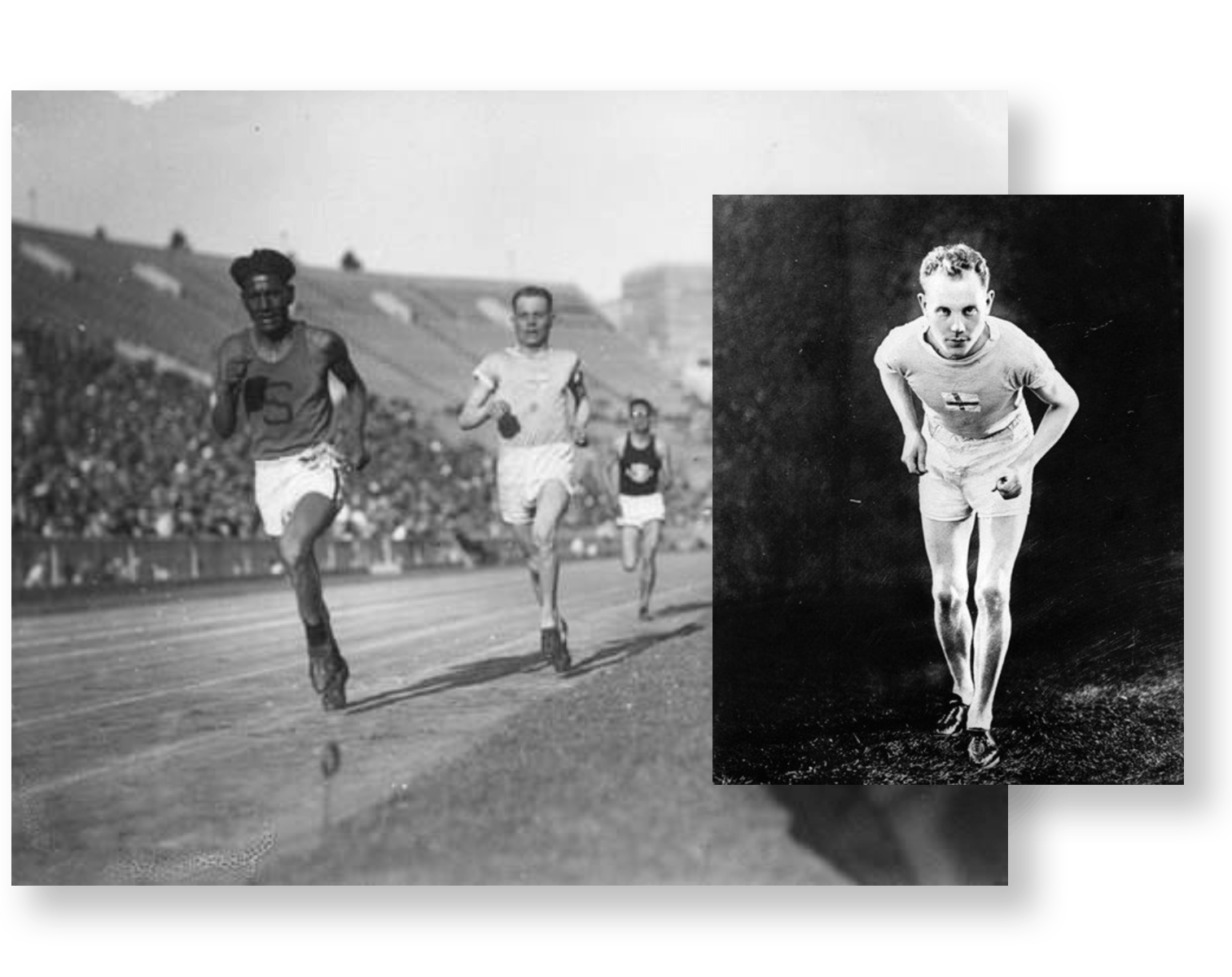
September 20
1927
Colonel Charles Lindbergh
Charles Lindbergh, the hero who piloted the first trans-Atlantic flight nonstop from New York to Paris, was greeted by 60,000 admiring fans at the Los Angeles Memorial Coliseum. Colonel Lindbergh flew into LA in the "Spirit of St. Louis" air cruiser, dipping and diving to all of those in awe on the ground. Following a cheerful parade that went from First and Broadway all the way to the Coliseum, Lindbergh delivered his speech which focused on bringing awareness towards the need for air supremacy in America, with every major city opening an airport and pioneering a new world of commercial aviation.
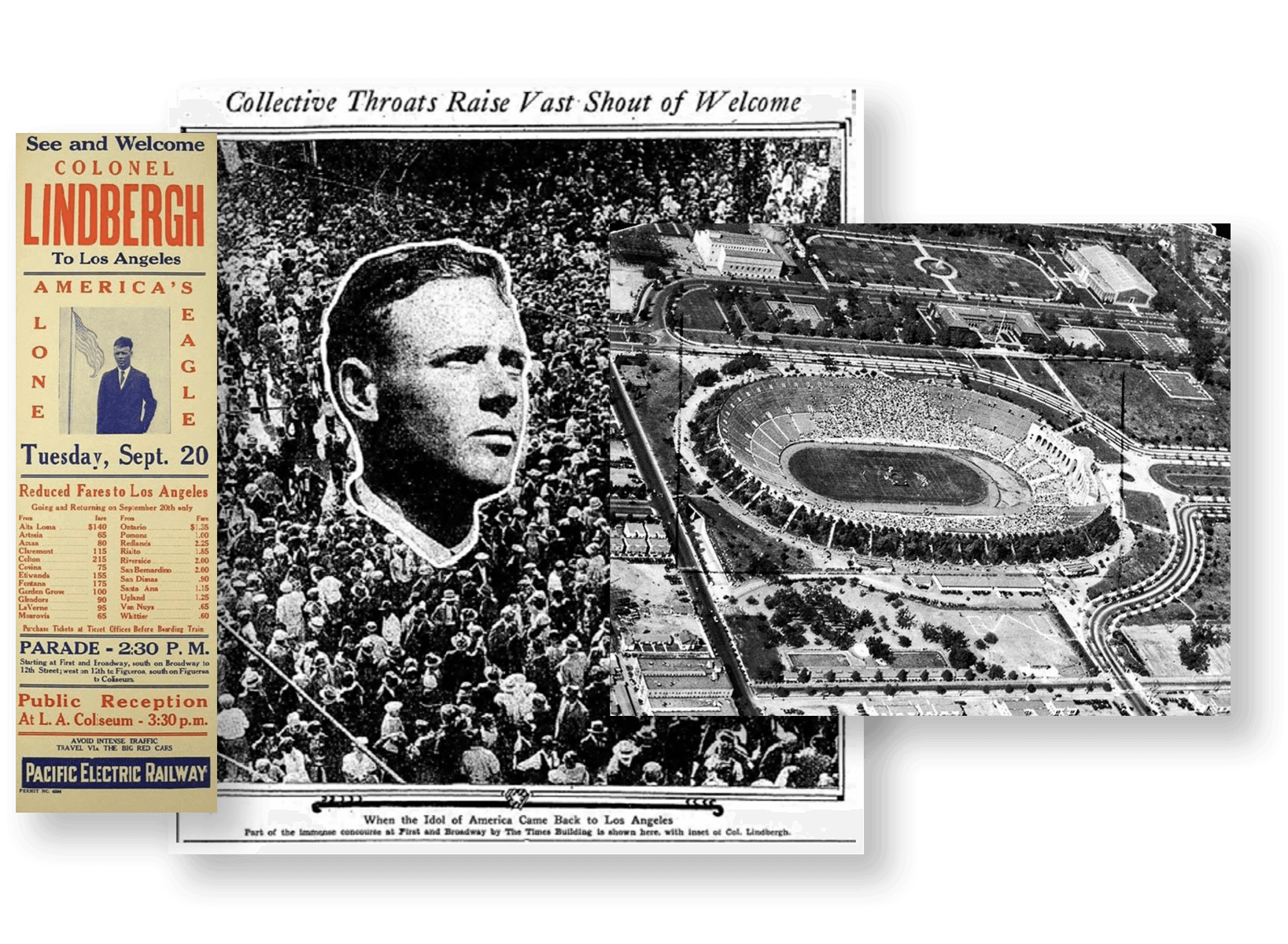
September 27
1927
“College” – A Silent Film Starring Buster Keaton
“College” is a 1927 comedy-drama silent film. The film takes place in Southern California, directed by James W. Horne and Buster Keaton. Keaton also stars in the film, alongside Anne Cornwall and Harold Goodwin. The film was screened at the Los Angeles Coliseum, making it the first movie to ever be played there.
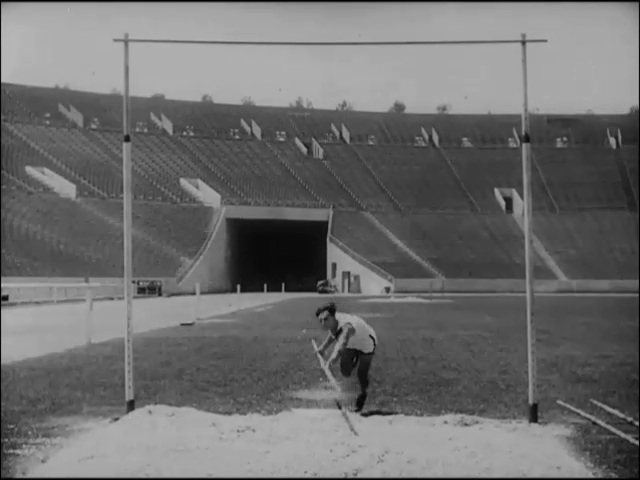
September 28
1929
First USC vs UCLA Matchup
While the Coliseum served as home field for both USC and UCLA at the time, the iconic crosstown rivalry met for the first time on September 28, 1929. The game was the season opener for both teams. USC was coming off its first national championship season while UCLA had just completed its first season in the Pacific Coast Conference. The Trojans were led by legendary coach Howard Jones and defeated the Bruins 76-0, which still stands as the most lopsided score of the series.
As of the 2022 season, USC leads the all-time series with 50 wins while UCLA has 33 wins. There have been seven ties in the series.
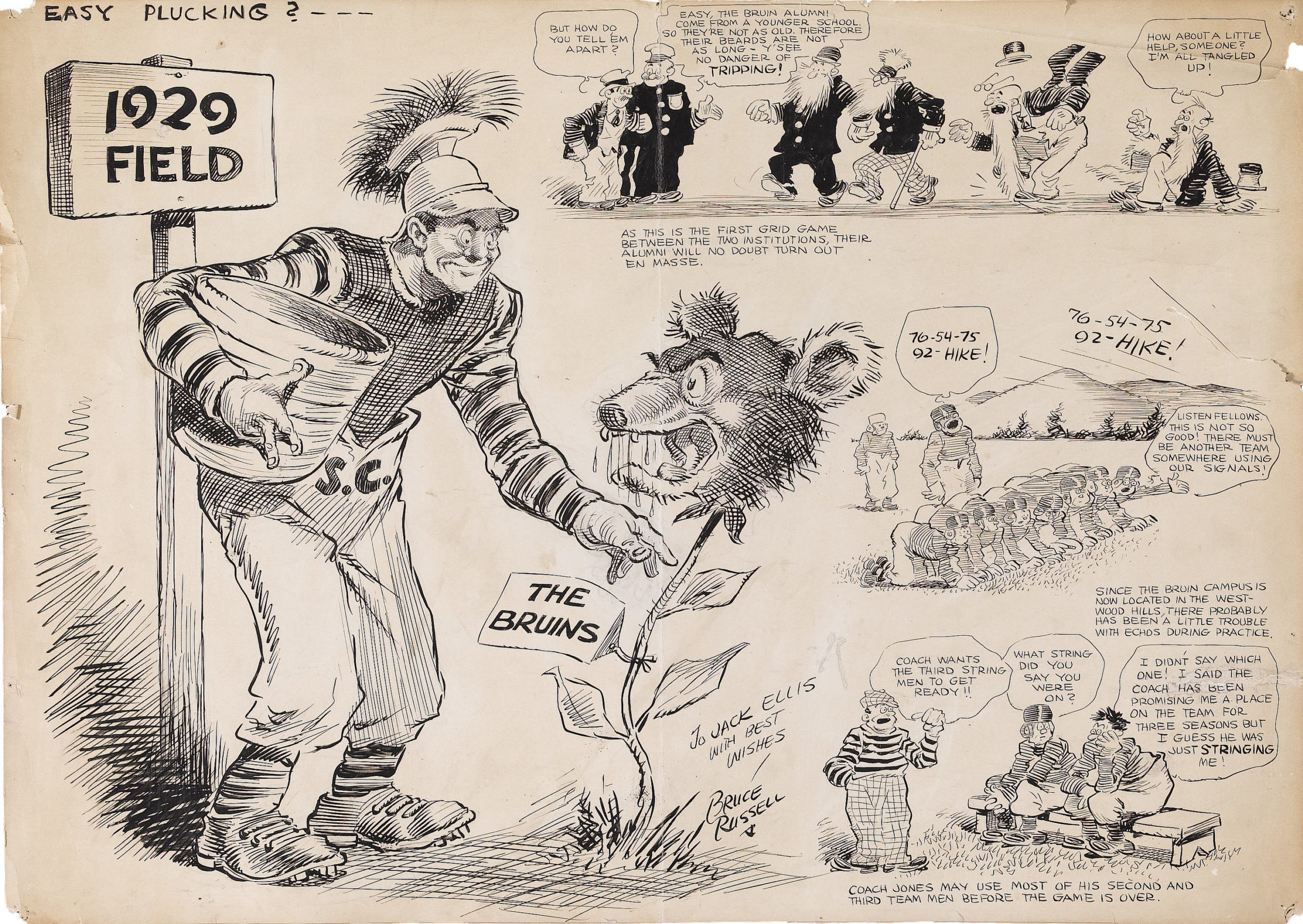
July 30
1932
X Olympiad Opening Ceremony
The 1932 Summer Olympic Games opened at the Los Angeles Memorial Coliseum on July 30, 1932. The crowd of 101,022 welcomed athletes from 37 countries, including the 357 men and 43 women competing on Team USA.
It is estimated that over 1.2 million fans from all over the world attended the Games (interestingly, the same number of people that were residing in the City of Los Angeles at that time). This was the first Olympics which involved the setup of an Olympic Village for the visiting athletes, and also premiered the use of a three-tier medal podium.
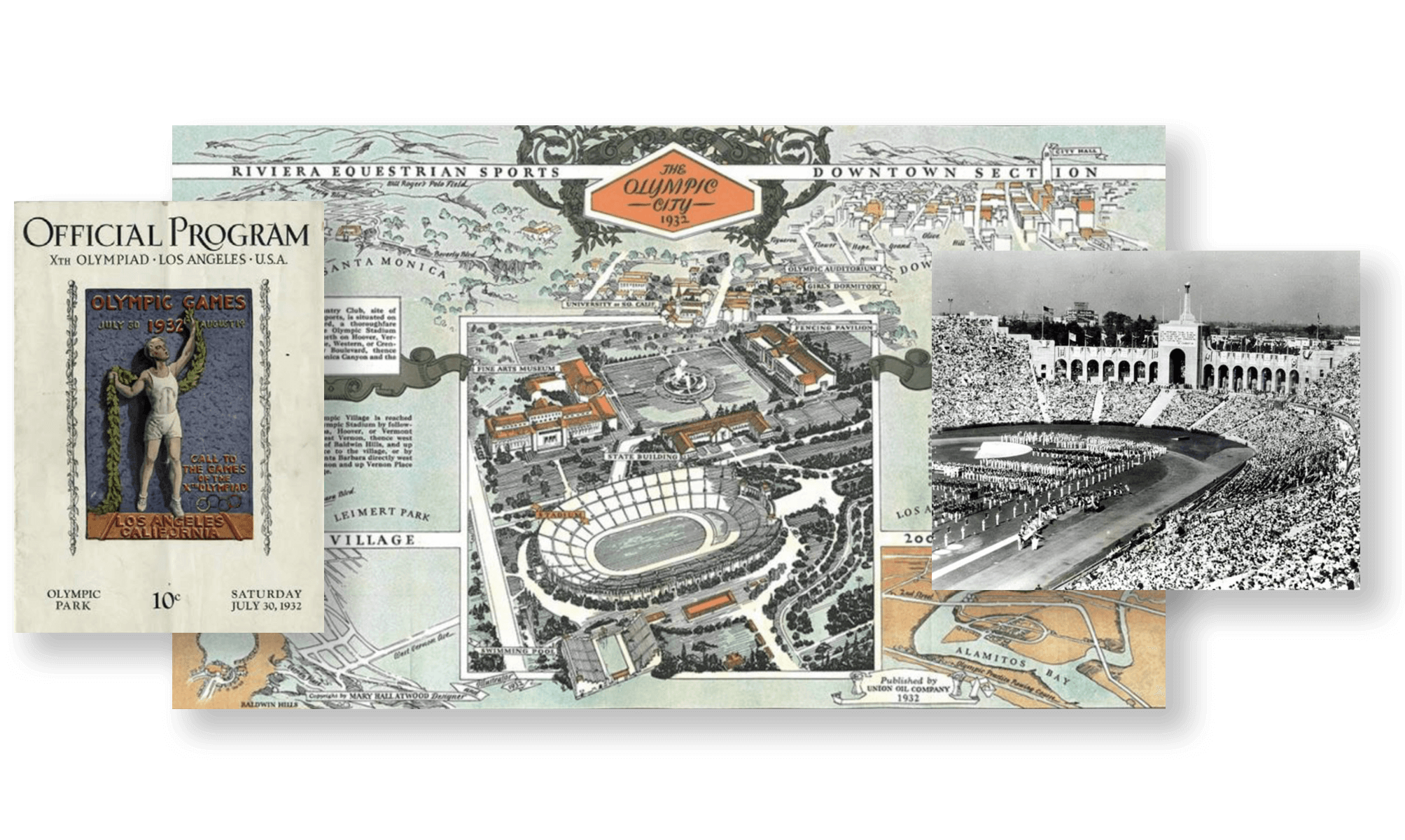
May 5
1934
Cinco de Mayo
Cinco de Mayo — or the fifth of May — is a holiday commemorating the date of the Mexican army’s 1862 victory over France at the Battle of Puebla during the Franco-Mexican War (1861-1867). A relatively minor holiday in Mexico, in the United States Cinco de Mayo has evolved into a celebration of Mexican culture and heritage, particularly in areas with large Mexican-American populations.
In 1934, the Los Angeles Memorial Coliseum celebrated its first Cinco de Mayo event which was an exciting culmination of both sports and carnival activities featuring athletes & performers of Mexican descent displaying their talents to all in attendance.
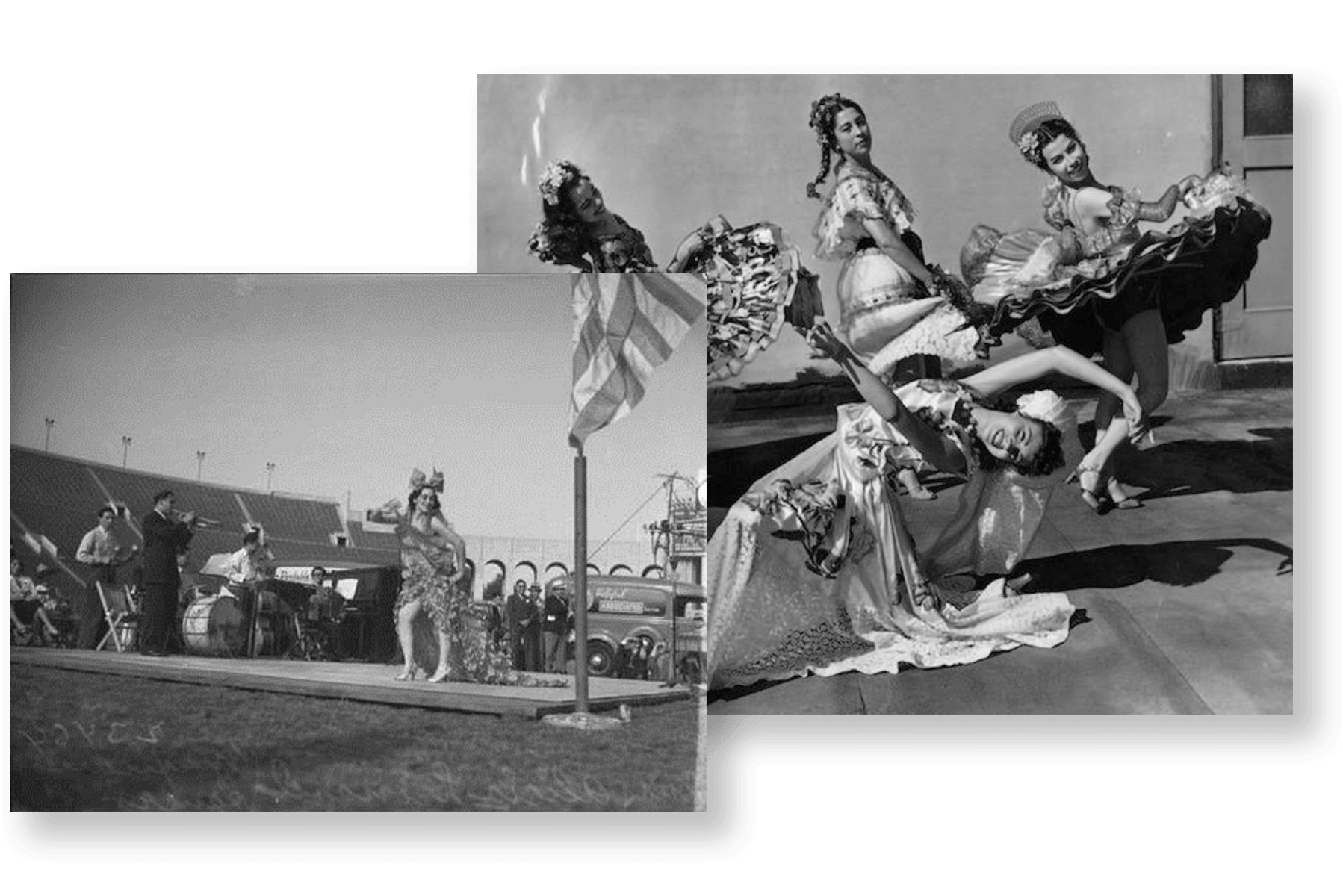
October 1
1935
Rally featuring U.S. President Franklin D. Roosevelt
During President Franklin D. Roosevelt’s first visit to Los Angeles as the President of the United States, he toured the city by motorcade. At the Los Angeles Memorial Coliseum, he addressed the crowd from his car with a speech rallying behind the “liberal spirit” of California, commemorating how “no state has a finer record in the great task of putting the strong arm of Government behind the less fortunate members of society.” The rally drew in a crowd of 70,000 people.
FDR had won the popular vote of the election with 57% of the votes and swept the electoral votes, receiving over 470. Besides the Coliseum, FDR was hosted with open arms in California, including a parade, events at the Hollywood Bowl and an evening of entertainment hosted by Jack Warner of Warner Bros, who later went on to produce movies supporting FDR’s policies.

July 31
1936
Norwegian Ice Queen
Today marks the 81st anniversary of the "Midsummer Ice Skating Carnival" held at the Coliseum. With tickets selling for only 30 cents, this was the first time that an ice skating exhibition was held at an outdoor football stadium. Headlining the event was world-famous figure skater, Olympian, and Hollywood actress, Sonja Heine. Known as the “Norwegian Ice Queen", Heine has been credited with putting the sport of figure skating on the map.
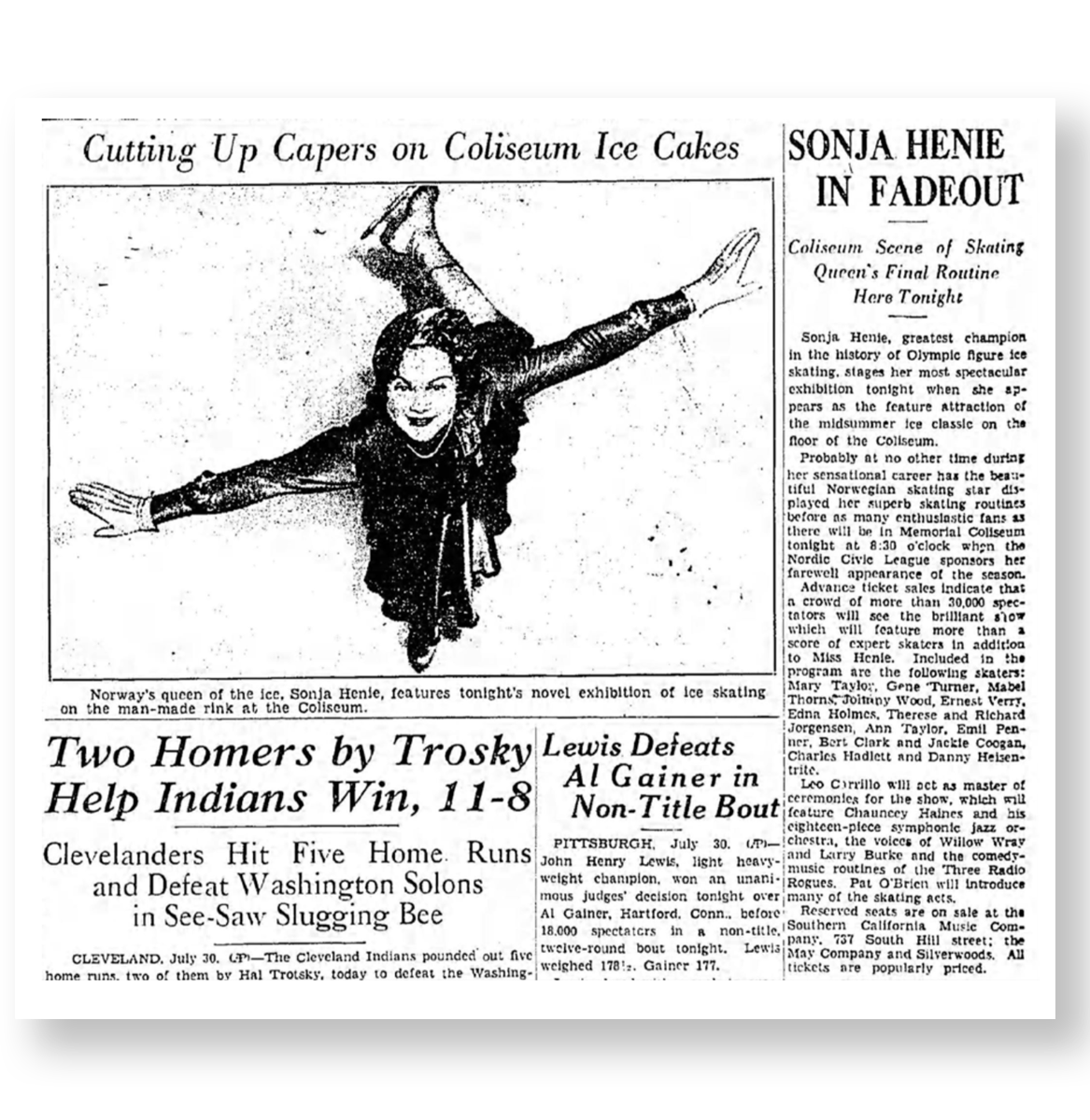
February 27
1938
1st Annual Southern California Ski Jump Competition
A reported 88,000 spectators turned out for the Southern California Open Ski Meet featuring a ski jump ramp built more than 50 feet above the rim of the Coliseum. Engineers used snow machines to cover the ramp with 500 tons of ice. The competition featured two-time Olympic gold medalist Birger Ruud of Norway.
In a time known as the "golden age" of this sport, thanks in part to the excitement of the 1932 Winter Olympics, other ski competitions were also held at the Hollywood Bowl and the San Francisco Golden Gate International Exposition on Treasure Island.
